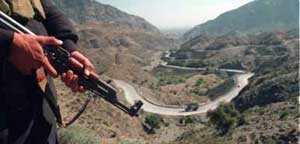AFGHANISTAN
U.S.-led occupation trapped at Khyber Pass
By
G. Dunkel
Published Jan 25, 2009 9:30 PM
The day Vice President-elect Joseph Biden visited Kabul, the current capital,
and Khandahar, the major city in southern Afghanistan, more than 600 Afghan
resistance fighters left Afghanistan and attacked a Frontier Corps outpost in
northwest Pakistan.
In the largest attack on Pakistani troops in months, guerrillas armed with
rocket-propelled grenade launchers and machine guns swarmed the fort on the
night of Jan. 10 and fought heavily through the next morning (Wall Street
Journal, Jan. 11). Unconfirmed reports said some Pakistani soldiers were
captured, six were killed and seven wounded.
Biden, the outgoing chair of the Senate’s Foreign Relations Committee,
finished a trip to Afghanistan and Pakistan on Jan. 11. The trip underlined the
significance that the incoming Obama administration places on the struggles in
Central Asia.
Khabrein.info, an India-based Muslim news service, reported three days of heavy
fighting in this area along the Afghan-Pakistan border. More than 76 people,
including six security personnel and five foreign militants, were killed in
that fighting.
Short reports in the press of countries with troops in
Afghanistan—France, Canada, Australia, Britain and the United
States—point to a pattern of small attacks, like roadside bombs and
suicide missions, that don’t produce big casualties on either side but
keep the pressure on the occupying forces.
Major fighting in the winter is unusual in Afghanistan, a rugged country with
few roads and heavy snow. So much activity on the part of the resistance forces
indicates they are confident they are winning and want to push their struggle
forward.
In many parts of southern Afghanistan, resistance forces control most of the
territory. (Los Angeles Times, Jan. 10) Resistance fighters don’t bother
the International Security Assistance Forces (ISAF) if they behave themselves
and stick to their (small) portions of the countryside.
Battles in other parts of Afghanistan
The Afghan military reports that on Jan. 15 a helicopter carrying one of
Afghanistan’s most senior army generals and 12 soldiers crashed in
western Afghanistan, killing all aboard. The army said poor maintenance and bad
weather were to blame. The Taliban said they shot it down.
In the center of Kabul on Jan. 17, a car bomb exploded on the road that links
the German embassy to a U.S. military base, in an area that is supposedly
well-guarded. At least three people were killed and 12 injured. The U.S.
military claims that only one U.S. soldier was killed but admits three were
evacuated to Baghram Air Force base. (New York Times, Jan. 18)
Occupation troop surge won’t stop resistance
U.S. Gen. Bantz Craddock, the supreme commander of NATO in Europe, feels that
substantial U.S. forces will be in Afghanistan for “at least” a
decade, with some presence for much longer. In an interview Jan. 10 with
Deutsche Welle, Germany’s news service, Craddock also admitted the U.S.
will be sending 30,000 more troops to Afghanistan in 2009.
About President Barack Obama’s desire to get the U.S.’s European
allies to do more, Craddock told DW, “I think it’s going to be
harder for them to do it because of decreasing defense budgets.” NATO
will have to find a way to replace the Dutch forces in southern Afghanistan in
2010 and the Canadians in 2011.
Pouring 30,000 troops into Afghanistan, a poor, totally undeveloped country
reeling from 30 years of war, is going to demand a major logistical buildup.
These troops will need, according to Gen. David McKiernan, the U.S.’s top
general in Afghanistan, more support items “like helicopters, engineers,
military police, transportation assets.” (Associated Press, Jan. 10)
Currently 80 percent of the supplies that ISAF/NATO and the U.S. use in
Afghanistan come through the Khyber Pass from the Pakistan seaport of Karachi,
with most of the rest coming either by air or through a smaller, more difficult
pass that leads to Khandahar. (Le Monde, Dec. 30) The U.S. has an agreement
with Russia to ship supplies from the Black Sea and then through Central Asia,
but that route is much more costly.
In mid-December, the attacks on supply depots in Peshawar, Pakistan, had grown
so deadly and extensive that truckers were refusing cargoes going to Kabul.
Even heavily protected convoys were attacked going through the pass.
Pakistan closed the pass in early January for three days, claiming they needed
to clear out the guerrillas in the area. There were hints in the reports
covering this operation that the Pakistani army was upset at U.S. drones
attacking Pakistani territory, but nothing was explicitly stated.
Syed Saleem Shazad, the Pakistan bureau chief of Asia Times Online (Hong Kong),
who is a widely published Pakistani journalist with an international
reputation, quotes a high-placed, unnamed Taliban strategist as saying,
“To cut the NATO’s supply lines in Pakistan is an important element
of our strategy. If it is applied correctly in 2008, it will lead to NATO
withdrawing its forces in 2009, but we might need another year.” (Le
Monde Diplomatique, October 2008)
Britain at the height of its imperial expansion was not able to control and
occupy Afghanistan in the 19th century. Given the economic downturn currently
afflicting Europe and the U.S., their strategic weaknesses and the implacable
resistance of the Afghan people to occupation, it is unlikely the U.S. will
succeed in the 21st century.
Articles copyright 1995-2012 Workers World.
Verbatim copying and distribution of this entire article is permitted in any medium without royalty provided this notice is preserved.
Workers World, 55 W. 17 St., NY, NY 10011
Email:
[email protected]
Subscribe
[email protected]
Support independent news
DONATE


